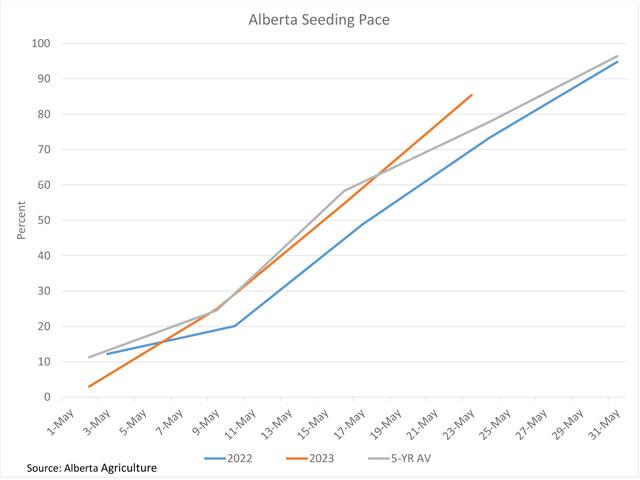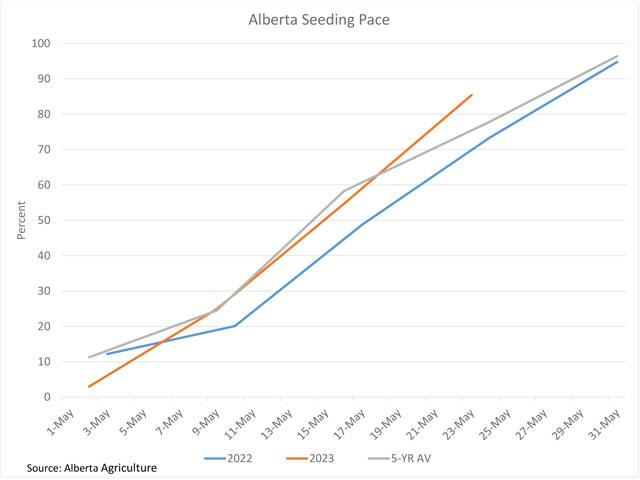Canada Markets
Alberta Spring Seeding Nearing an End
The Alberta Government's latest Crop Report for the week ending May 23 shows an estimated 85.4% of the spring seeding complete, up from 55% estimated for the previous week, the five-year average of 79.8% and the 10-year average of 80.1%. This is the fastest pace of spring seeding seen for this week since 2021.
Despite running well-behind average, the Southern Region has caught up to its five-year average at 89.4% complete, while the Central Region remains 1.7 percentage points behind average at 83.3% complete, the Northeast region is 3.9 points ahead of average at 85%, the Northwest region is 13.9 points ahead of average at 82.7% complete and the Peace Region is 22.2 points ahead of average at 85% complete.
An estimated 93% of the spring wheat (80.3%), 83.7% of the oats (68.2%), 72.7% of the barley (48.5%), 78.5% of the canola (64.4%) and 93.2% of the dry peas (87.5%) were estimated seeded as of this date, with the five-year average in brackets.
The provincial government noted rapid emergence across the province, with an estimated 47% of crops rated as emerged, 15 percentage points ahead of the five-year average. While emergence is 2 points behind average in the Southern Region, it is 10 percentage points above average in the Central Region, 12 points ahead of average in the Northeast Region, 30 points ahead of average in the Northwest Region and 40 points ahead of average in the Peace Region.
P[L1] D[0x0] M[300x250] OOP[F] ADUNIT[] T[]
To highlight the most northern Peace Region, reported data during the past seven years has shown emergence further ahead in 2016 at 58% emerged, while four of the seven years reported emergence at less than 3%, including 2% reported for the same week in 2022.
The province's surface soil moisture rating is shown to rise to 52.1% good-to-excellent for the province, with this rating for the province reported from 51% to 54% during the four weeks reported in 2023. This is well below the five-year average of 67.2% G/E and the 10-year average of 69.1%. Looking at past years' data, the provincial average is close to the 48% reported in 2022, the 55.1% reported in 2019 and the 54.6% reported in 2015.
If you missed DTN's Ag Summit Series event, "Crop Updates From the Field" or were too busy to register, here is a second chance. Register now and you'll be able to access recordings of the event in which we visited with farmers from across the country, talked about the latest dicamba and pesticide news and discussed DTN's latest weather and market outlooks. This extended registration period will close on June 5 at 5 p.m.
Here's the link to register:
There may be a time delay between when you register and when you can access the recordings.
Cliff Jamieson can be reached at cliff.jamieson@dtn.com
Follow him on Twitter @Cliff Jamieson
(c) Copyright 2023 DTN, LLC. All rights reserved.






Comments
To comment, please Log In or Join our Community .